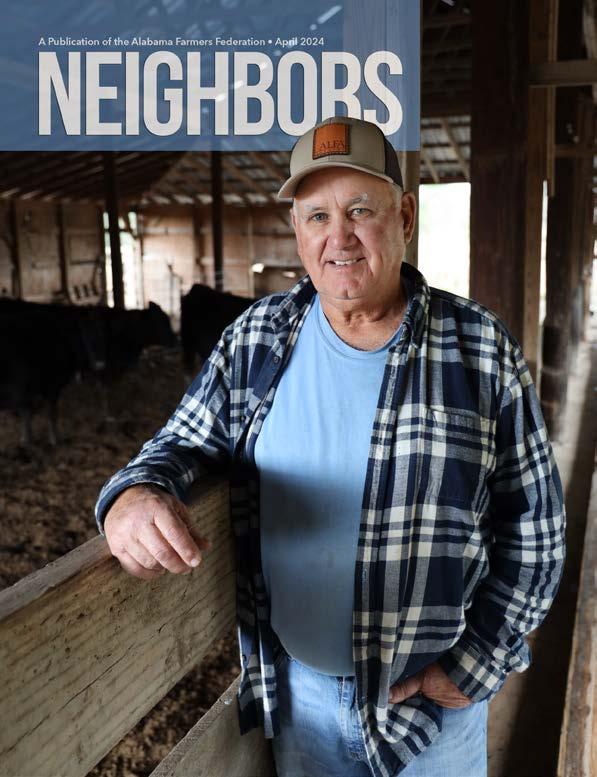
Farmers Optimistic Despite Cattle
Soil Health Practices Pay Off Benefits of Controlled Burns
Inventory
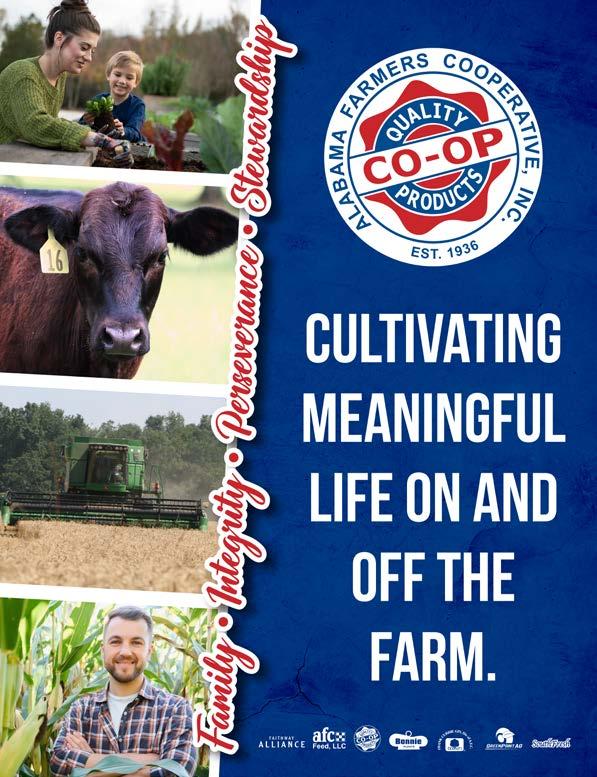
April 2024 | Volume 49 | Number 3
Marlee Jackson | Editor
Laura Unger | Graphic Designer
ALABAMA FARMERS FEDERATION
Paul Pinyan Executive Director
Jeff Helms | Director of Communications
FEDERATION OFFICERS
Jimmy Parnell | President, Stanton
Rex Vaughn | Vice President | North, Huntsville
Jon Hegeman Vice President | Central, Anniston
George Jeffcoat Vice President | Southeast, Gordon
Jake Harper | Vice President | Southwest, Camden
Steve Dunn Secretary-Treasurer, Evergreen
DIRECTORS
Dorman Grace | Jasper
Jeff Peek | Athens
David Bailey | Dawson
Steve Lake | Vinemont
Joe Anders Northport
Phillip Hunter | Birmingham
Joe Lambrecht | Wetumpka
Tommy Martin | Moundville
Bill Cook Montgomery
Trip Horne | Louisville
Mark Kaiser | Daphne
Jerry Peak | Chancellor
Debbie Dunn Samson
Dillon Turk | Semmes
Neighbors (ISSN 0162-3974) is published monthly by the Alabama Farmers Federation, 2108 East South Boulevard, Montgomery, Alabama 36116 or (334) 288-3900. For information about Alabama Farmers Federation member benefits, visit the website www.alfafarmers.org. Periodicals postage paid at Montgomery, Alabama, and additional mailing offices.
Printed in the U.S.A.
POSTMASTER
Send address changes to Neighbors P.O. Box 11000, Montgomery, Alabama 36191-0001
MEMBERSHIP AND SUBSCRIPTION CHANGES
800-392-5705, Option 4 or BWatkins@alfafarmers.org
ADVERTISING REPRESENTATIVE
Ben Shurett, (256) 997-7922
BenShurett.alfafarmers@gmail.com
DISCLAIMERS: Advertisements in Neighbors do not represent an endorsement by the magazine or Alabama Farmers Federation. Editorial information from sources outside the Alabama Farmers Federation is sometimes presented for our members. Such material may, or may not, coincide with official Alabama Farmers Federation policies. Publication of information does not imply an endorsement by the Alabama Farmers Federation.
www.AlfaFarmers.org



 Photo By Maggie Edwards
Photo By Maggie Edwards


4 In This Issue 4 | USDA Predicts Drastic Drop in Farm Income 6 | Legendary Leaders Earn Entry to Hall of Honor 8 | Landowners Lean on Fire to Improve Habitat 14 | Alabama Has Fewer Farms, Per Census of Agriculture 17 | Soil Health Practices Pay Dividends for Farmers 10 On The Cover Mark Landers of Tuscaloosa County is optimistic about the state’s cattle industry despite decreased inventory noted in a recent report. Alabama has 6% fewer head of cattle and calves as of Jan. 1.
28 | Simple Southern Staples for Spring Entertaining 28 8 alfafarmers.org April 2024 | NEIGHBORS | 3
Farmers Buckle Down as USDA Predicts Income Dip
 By Marlee Jackson
By Marlee Jackson
Just two years after the roller coaster of net farm income reached a record peak, farmers are buckling in for a bumpy ride as profitability is predicted to plummet.
National net farm income is forecast to drop to $116 billion, per the U.S. Department of Agriculture (USDA). Adjusted for inflation, USDA’s prediction is a whopping 40.9% decrease from 2022’s historic high income of $185.5 billion.
“We’ve had $3 and $4 corn before, but we didn’t have these elevated fertilizer, chemical, seed and repair costs,” said John Bevel, who grows row crops in Marshall and Jackson counties. “2024 is not looking very good unless you have really high yields.”
USDA insights help gauge profitability for farmers like Bevel.
In 2024, the national agency expects a decrease in agricultural exports for the third time in five years. The anticipated $8.3 billion decline means exports will
total just $170.5 billion. Meanwhile, farm debt is expected to reach $27 billion, a 5.2% increase.
Analyzing those trends is complex, said the Alabama Farmers Federation’s Chris Prevatt. He’s a commodity director and economist who daily scours market data for its impact on farmers.
Market prices and production costs spiked mid-pandemic, he said. Those
Take Bevel’s farm.
Since the pandemic, chicken litter for fertilizer has increased from $550 a ton to $900 — a 60% increase. Nitrogen shot up 33% to $300. Corn seed increased 25% to around $325 a bag.
Meanwhile, corn hovers around $4 a bushel. That’s near the pre-pandemic price when input costs were considerably lower.
Market prices have fallen across commodities, while overall input costs are increasing for the sixth straight year thanks to global pressures and inflation.
problems coincided with global issues like the war in grain-giant Ukraine. That conflict spurred an increase in U.S. production, though prices then tanked as Ukrainian grain eventually flooded the market, Prevatt said.
Market prices have fallen across commodities, while overall input costs are increasing for the sixth straight year thanks to global pressures and inflation.
“Corn would need to be $5.25 a bushel just to keep the same pace as input cost increases,” said Bevel, who serves on the Federation’s State Wheat & Feed Grain Committee. “I don’t think anyone is going to be wasting any money, but you still have to take care of the crop so you make a good yield — if we get the rain we need. You can’t cut back too much.”
John Bevel farms in Marshall and Jackson counties. He and fellow farmers are buckling down even more on efficiency in light of predicted net farm income drops in 2024.
4 | NEIGHBORS | April 2024 alfafarmers.org
While plunging market prices trouble row crop farmers, State Catfish Committee member Travis Wilson said subsequent lower feed costs could improve his farm’s bottom line.
Travis raises catfish in Dallas County with his father, Butch, and brotherin-law, Willard Powe. Feed makes up around 60% of their catfish production costs, and that cost has ticked upward in the last five years. Travis secured feed at under $400 a ton in 2019. It’s just below $500 today, though feed reached $550 last year.
Catfish helps keep the Black Belt Region afloat, even as production has become more difficult since the early 2000s when foreign, low-quality fish began flooding the market.
Butch said fluctuations — in price plus supply and demand — mean planning is critical.
“You just live within your means, and you hope that your means are what you thought they’d be 12 months from now (when you get paid),” said Butch, who survived devastating near-20% interest rates of the early ‘80s. “You’re not going to have deflation. This is the new norm.”
Travis continued, “All the numbers are higher on our farm — expenses and income — but the rate of return is not as good.”
In the nation’s capital, U.S. Sen.

Tommy Tuberville, R-Ala., is working to help farmers weather the financial storms.
He serves on the Senate Ag Committee, where he’s fighting for a new farm bill as ranking member of the Subcommittee on Rural Development and Energy. The 2018 legislation was extended when partisan politics prevented a new bill in 2023.
“Many farmers are having to make the difficult decision of either staying in business and losing money or selling their farms,” Tuberville said. “Food security is national security. That’s why I’m going to continue fighting for Alabama’s agriculture priorities, including bringing down input costs, increasing reference prices and protecting crop insurance to ensure an effective safety net is available.”
More relief could be on the way if the Federal Reserve lowers interest rates, though the change would be
minor, said the Federation’s Prevatt.
Despite this year’s outwardly bleak farm outlook, Prevatt noted the cyclical nature of farming — and concept of refinement through fire.
“Tough times are going to make the ones who survive stronger, and they’ll do even better in the next part of the decade,” Prevatt said.
alfafarmers.org April 2024 | NEIGHBORS | 5
Father-son duo Butch and Travis Wilson raise catfish in Dallas County and are still battling higher input costs four years after the COVID-19 pandemic and associated supply chain issues began.
Honored for Service to Agriculture LEGENDARY LEADERS
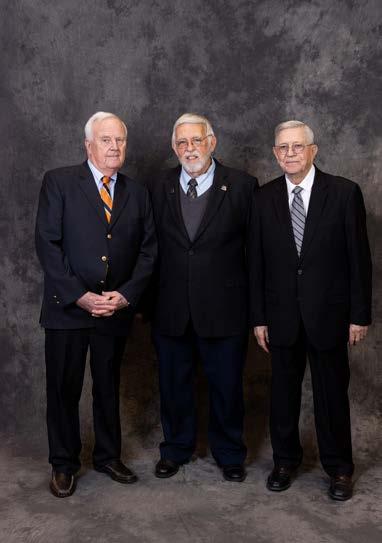 By Marlee Jackson
By Marlee Jackson
Five legendary leaders were honored for their impact on Alabama agriculture Feb. 13 in Auburn. Hollis Isbell, Don Ball and Bill Stallworth were inducted into the Alabama Agriculture Hall of Honor, while families of the late Mark Nichols and Wade Skidmore accepted Pioneer Awards.
Auburn University Agricultural Alumni Club President Brian Hardin hailed the honorees and their families. The club organizes the annual awards banquet.
“It’s our honor to recognize these five men for strengthening Alabama agriculture,” said Hardin, also the Alabama Farmers Federation External Affairs Department director. “Speaking with them and their families is a highlight of my year. They are humble, generous people who have made this state and its people better.”
The Hall of Honor was established in 1984. Isbell, Ball and Stallworth join 118 prior inductees.
Isbell of Colbert County is a cotton farmer, nationally known agriculture advocate and this year’s production
category honoree. Key contributions to agriculture include supporting the Boll Weevil Eradication Program, which saved Southern fiber production; being at the forefront of irrigation investments in the Tennessee Valley; and establishing two cotton gins and warehouses. Isbell’s past leadership positions include chairing the American Cotton Producers, the Alabama Cotton Commission and the Federation’s State Cotton Committee.
Ball was honored for work in education and government. A forage expert, Ball impacted countless farmers over his 35-year career as an Alabama Cooperative Extension System agronomist. The Kentucky native co-authored “Southern Forages,” still considered the most important practical forage resource after 31 years in publication. There are more than 50,000 acres of his registered Russell bermudagrass across the Southeast.
Stallworth of Monroe County was inducted in the agribusiness category. Stallworth founded The Buffalo Co., a large agricultural brokerage firm that impacted livestock and poultry industries across six Southeastern states. Known for his generosity, Stallworth has funded scholarships at three colleges and helped create AU’s Ag International Program, which facilitates global travel for students majoring in agriculture.
During the banquet, posthumous Pioneer Awards honored Nichols and Skidmore. Fifty-seven Pioneer Awards have been presented since 1996.
Nichols was an early professor in AU’s College of Agriculture. The namesake of the Nichols Terrace, he was a pioneer in soil erosion control. Nichols is known as the father of agricultural engineering at AU.
Skidmore was a Marshall County cattle and poultry farmer lauded for advocacy on behalf of fellow producers. He was past president of the Alabama Poultry & Egg Association and served as a liaison between city residents and farmers in north Alabama.

Scan to learn more about Hall of Honor and Pioneer Awards. 6 | NEIGHBORS | April 2024 alfafarmers.org
Legendary leaders were inducted into the Alabama Agriculture Hall of Honor Feb. 13 in Auburn. From left are Bill Stallworth, Don Ball and Hollis Isbell.


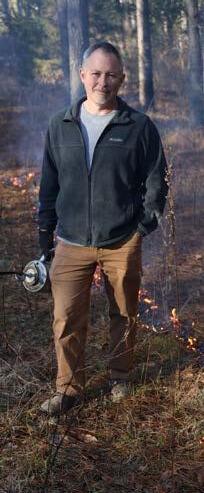


 By Tanner Hood
By Tanner Hood
Smoke rises and flames snap, crackle and pop through forest undergrowth as Scott Woodall uses a drip torch to ignite a controlled burn in remote Jackson County.
“Fire can be used to promote better wildlife habitat and knock back competition so desired trees and plants can capitalize on the water and nutrients not being consumed by unwanted vegetation,” said Woodall, founder of Sportsman’s Wildlife and Timber, a habitat management company for local landowners.
Controlled burning, a practice originally attributed to Native Americans, is growing in popularity, said Woodall.
For many, fire that spreads across acres is associated with uncontrolled
blazes in places like California where lack of planned burns has left land coated in ready fuel. Fire in that vein is unlikely in Alabama, Woodall said.
“I don’t believe the climatic conditions exist normally for us to be at quite as high of a risk like they are on the West Coast,” Woodall said. “Active forest management helps mitigate those issues.”
Alabama’s climate offers ideal times to burn, Woodall said.
“Most burning is in the winter and spring because it can be difficult to burn in Alabama humidity,” said Woodall, the Jackson County Farmers Federation secretary and Alabama Farmers Federation State Forestry Committee member. “Weather is also an obstacle because it’s so unpredictable.”
When the fires eventually get going and smoke starts rolling, burns can be
8 | NEIGHBORS | April 2024 alfafarmers.org
Left: Scott Woodall of Sportsman’s Wildlife and Timber uses a drip torch to ignite controlled burns for landowners in northeast Alabama. Above: The before-and-after effects of prescribed fire on grasslands are separated by a fire break in Jackson County.
beneficial for landowners.
Woodall is a prescribed burn manager, which means he’s certified to conduct effective and reliable burns. However, landowners with appropriate equipment and manpower can request a burn permit through the Alabama Forestry Commission.
“When we burn for a landowner, our objective is reaching their goals for what they want out of the land,” Woodall said. “Fire breaks are then established to help prevent escapes, and fire is applied.”
For Woodall’s clients, goals include promoting better wildlife habitat, improving native browse and site-prepping timber land after clear-cutting.
Auburn University Associate Professor of Wildlife Ecology and Management Dr. William Gulsby said controlled burns are an effective way to reach those targets.
“Controlled burning, also known as prescribed fire, is a cost-effective tool to manage vegetation communities for a variety of game and non-game wildlife species,” Gulsby said. “For example, prescribed fire reduces the height of vegetation. This ensures cover from inclement weather and predators is readily available for ground-dwelling wildlife and keeps food sources within reach.
Controlled burning also increases the palatability, nutrient content, digestibility, productivity and prevalence of important forage plants while promoting popular game-species
growth, Gulsby said.
“Periodic fire is a cost-effective way to increase habitat quality for our state’s most popular game species: white-tailed deer and wild turkeys,” Gulsby said. “There are also several game and non-game species that only inhabit areas that are frequently burned. For example, northern bobwhite quail, red-cockaded woodpeckers, gopher tortoises and Bachman’s sparrows disappear completely from areas about five years after burning.”
Ideal quail habitat pushes Gary Bryant to rely on prescribed fire.
“Fire is the best tool in the box,” said Bryant, who manages Kowike Creek in Russell County and is a member of the State Wildlife Committee. “It’s the cheapest and easiest method to kill unwanted vegetation and promote cover and food for the quail.”
With over 3,000 acres to manage, Bryant has developed a burn rotation to maximize growth. Land is sectioned off with separate portions being burned in different years.
Innovative ideas make burning effective for Bryant’s operation. That includes using previously established roads as fire breaks and a homemade drip torch attachment for a tractor.
“I use a tractor with an electric burner and fuel tank,” Bryant said. “It’s wired to my turn signals, so when I flip

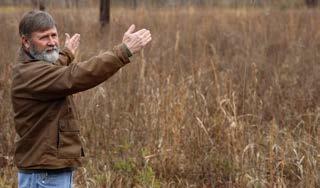
the indicator, fire comes out of that side of the tank. I tell everyone they better watch out when they see my signal.”
Tending the fire isn’t a one-man job. Bryant typically has two others on four-wheelers and tractors with water tanks and sprayers to prevent accidental spread and keep the fire under control.
He’s also aware of shifts in weather patterns, like wind, that affect burns.
“It’s all necessary for beneficial growth and wildlife development,” Bryant said. “We want wax myrtles to grow like bushes for quail cover, and it takes fire. We plant partridge peas and ragweed for deer and turkeys, but we must burn the area to plant. For us, it revolves around the fire.”
Federation Wildlife Division Director William Green said he’s thankful to see revived interest in controlled burns.
“We encourage our landowners to use fire in a safe, responsible and productive way,” Green said. “Burns are becoming more commonplace and, when used correctly, allow wildlife and vegetation to grow in ways not seen in decades.”
Back in Jackson County, Woodall examined sprigs of new green grass rising through the char of a recent fire.
“Burning has a place in our ecosystem,” Woodall said, “and as stewards of the land, we must use it proactively.”
Scan for burn permits through the Alabama Forestry Commission.


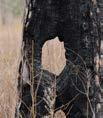
April 2024 | NEIGHBORS | 9
Above from left: Kowike Creek Farm Manager Gary Bryant points out a previously burned area and the growth that’s occurred since; Bryant’s homemade tractor torch attachment combines ingenuity and practicality to efficiently burn large areas; A wax myrtle regrew as a bush after a burn and provides cover for quail and other wildlife; Residual burn scarring shows how hot controlled burns can get. alfafarmers.org
Cattle Farmers Hopeful Despite Decreased Inventory
 By Maggie Edwards
By Maggie Edwards
Alabama farmers like Clay County’s Chris Upchurch remain hopeful for the cattle industry despite a recent national inventory report.
“The number of cattle we have is at a 50-year low, but the flip side to that is we are producing more beef at a higher quality than we ever have,” said Upchurch, an Alabama Farmers Federation State Beef Committee member. “Producers are more efficient because of the decades of research we have put in.”
Inventory of U.S. cattle and calves measured 87.2 million head as of Jan. 1. That national count is down 2% from last year, while Alabama has 6% fewer head, according to the U.S. Department of Agriculture (USDA). The report showed the Top 10 cattle-producing states are down 716,000 head from 2023.
The decline is due to the difficult farm economy, said Federation State Beef Committee member Whitney Blackmon.
“It’s hard to be profitable in the beginning,” said Blackmon, who manages the Auburn University Beef Unit and runs a commercial cow-calf operation in Tallapoosa County. “There are so many inputs for cattle producers that most people don’t think of — fencing, feedstuffs, cattle and land to name a few. The prices just keep rising.”
Natural disasters can be a factor, too. Wildfires, like recent devastation in Texas, can cause loss in the thousands. Last year’s Southern drought took a toll,

too, as farmers faced limited grazing for cattle and had less hay on hand.
Thanks to hard-working farmers like Upchurch, Blackmon and Tuscaloosa County’s Mark Landers, production of beef continues to rise. Since the ‘70s, there’s been a 25% increase in pounds produced, said Federation Beef and Hay & Forage Divisions Director Chris Prevatt.
“Good genetics make a difference,” Prevatt said. “We have more knowledge and use of feedstuffs, which allows us to put more gain on our cattle.”
In the 1970s, the U.S. had around 2 million cattle producers. The nation nears just half a million today. That’s a 75% decrease.
Despite seemingly bleak numbers, Blackmon isn’t discouraged.
“It looks scary,” she said, “but we have to look at the pounds of production. We are producing more pounds per animal now.”
Farmers keep moving forward regardless of challenges, Landers said.
“Our industry has shifted,” said

Landers, a Federation State Hay & Forage Committee member. “Now more than ever we’re tasked with a tough job — feeding the growing population.”
Cattle farmers face the facts: Farming has tough years and slow seasons, though the good outweighs the bad, Prevatt said.
“Beef is in so many people’s diets,” Prevatt added. “There will always be a need for those who produce U.S. cattle.”
It’s important to focus on herd health and quality instead of quantity, Upchurch said. The Clay County Farmers Federation president concentrates on the family aspect of farming, too.
He, wife Jordyn and son Charlie own Rockin’ U Farm in Lineville, where they have a cow-calf operation and sell freezer beef. Charlie, 5, makes the pasture his playground and loves riding in the side-by-side to help with farm chores.
That matters, Upchurch said.
“I stay in the industry because it’s a great way to raise my family,” he said. “If we don’t do it, who will?”
Chris, Jordyn and Charlie Upchurch
Mark Landers
10 | NEIGHBORS | April 2024 alfafarmers.org
Whitney Blackmon

L o w i n t e r e s t l o a n s f o r
A l a b a m a ’ s m e a t
p r o c e s s o r s a n d
s l a u g h t e r f a c i l i t i e s


a g i . a l a b a m a . g o v / m p i l p /

Advice for what matters most, when you need it most
Congratulations to S. Wesley Carpenter for being named to the 2023 Barron’s “Top 1,200 Financial Advisors” list, published on March 10, 2023. Rankings based on data as of September 30, 2022.


S. Wesley Carpenter, CPWA®, CFP ®, ChFC® Managing Director Senior Resident Director –Wealth Management Advisor Portfolio Manager 251.990.2361 wesley_carpenter@ml.com
Merrill Lynch Wealth Management 601 North Section Street Fairhope, AL 36532 fa.ml.com/thehartycarpentergroup
2023 Barron’s “Top 1,200 Financial Advisors” list. Opinions are Barron’s who evaluated advisors with a minimum of seven years financial services experience and employed at their current firm for at least one year. Ranking spots determined by each state’s population and wealth. Other quantitative and qualitative measures include assets under management, revenues generated for the firm, quality of practice, regulatory records, internal company documents and 100-plus points of advisor-provided data. Rankings do not reflect any one client’s experience, endorse any advisor and do not guarantee future investment success. Compensation was not received from anyone for the study. Barron’s is a trademark of Dow Jones & Company, Inc. All rights reserved.
Merrill Lynch, Pierce, Fenner & Smith Incorporated (also referred to as “MLPF&S” or “Merrill”) makes available certain investment products sponsored, managed, distributed or provided by companies that are affiliates of Bank of America Corporation (“BofA Corp.”). MLPF&S is a registered broker-dealer, registered investment adviser, Member SIPC and a wholly owned subsidiary of BofA Corp.
Banking products are provided by Bank of America, N.A., Member FDIC and a wholly owned subsidiary of BofA Corp.
Investment
products: Are Not FDIC Insured Are Not Bank Guaranteed May Lose Value
The Bull Symbol and Merrill are registered trademarks of Bank of America Corporation. CPWA® is a registered certification mark of the Investments & Wealth Institute®. For more information about the Institute and the CPWA certification, please visit investmentsandwealth.org. CFP Board owns the marks CFP®, CERTIFIED FINANCIAL PLANNER™, and CFP® (with plaque design) in the U.S. The ChFC® is the property of The American College of Financial Services, which reserves sole rights to its use, and is used by permission.
A Portfolio Manager can help clients pursue their objectives by managing on a discretionary basis his own Personalized or Defined Strategies, which may incorporate individual stocks and bonds, Merrill model portfolios, and third-party investment strategies.
© 2023 Bank of America Corporation. All rights reserved.
MAP4960336
| AD-11-23-0043 | 472538PM-1022 | 11/2023
April 2024 | NEIGHBORS | 11
alfafarmers.org
Alabama Young Farmers Born to Succeed



 By Maggie Edwards
By Maggie Edwards
Hard work, resiliency and positivity.
Those concepts encouraged 445 Young Farmers during the Alabama Farmers Federation Young Farmers Conference Feb. 9-11 in Gulf Shores.
“In life, we face many obstacles, especially as farmers,” said keynote speaker Braxten Nielsen during the opening banquet. “There are many things out of our control, but the first thing we can control every day is our mindset.”
Nielsen, a former bareback rider, inspired the packed room of 18- to 35-year-old farmers by sharing how he overcame a life-altering rodeo accident.
“As you work through challenges, you’ll find your true character,” Nielsen said. “You are born to succeed. You are a child of God. You can make things happen because of the greatness inside of you.”
That success can come from one’s sphere of influence, he added.
“One of the most important things
you can do is surround yourself with greatness,” Nielsen said while scanning the room of attendees. “Put yourself with people who believe in you, people like those at this conference.”
Relationship building is just one reason events like Young Farmers Conference are important, said Federation Young Farmers Division Director Hunter McBrayer.
“It’s about networking, leadership and the opportunity to participate in a grassroots organization,” McBrayer said. “Over 400 Young Farmers coming to learn and grow together is a big deal.”
Educational sessions kicked off Day 2 with a presentation from Corbitt Wall of DV Auction and the Feeder Flash YouTube channel. Wall delivered insights about cattle markets.
The group then split into breakout sessions with topics ranging from legal updates and Alfa Insurance farm policies to diversifying markets for farm products.
“All farmers have the same issues, even if we raise different commodities,”
said Federation State Young Farmers Committee member Forrest Anders of Morgan County. “We have a diverse state, but this year’s speakers had impactful messages for everyone.”
Joy Funderburk’s biggest takeaways were from the estate planning and tax readiness workshops.
“I am 29, so estate planning isn’t something I tend to think about, but the session encouraged our generation to be prepared,” said Funderburk, whose family owns Little Mountain Growers in Elmore County. “This conference feels like a family reunion. I met new people within the industry and built a camaraderie with other Young Farmers trying to succeed.”
Federation State Young Farmers Committee Chair Dillon Turk thanked fellow Young Farmers for organizing the event.
“This is the biggest Young Farmers Conference the organization has ever had,” said Turk, whose family owns a nursery in Mobile County. “It’s an opportunity to take your family and
12 | NEIGHBORS | April 2024 alfafarmers.org
Below from left: Corbitt Wall of Feeder Flash and DV Auction visited with Federation State Young Farmers Committee member Emmanuel Bankston of Houston County; Federation State Young Farmers Committee member Jonathan Edgar of Elmore County displayed a live auction item donated by the Barbour County Farmers Federation; State Young Farmers Committee members Bart Williams of Autauga County, Cal Logan of Greene County, Dillon Turk of Mobile County, Denzil Dees of Sumter County and Forrest Anders of Morgan County greeted 445 conference attendees in Gulf Shores.
fellowship with farmers across the state. I encourage everyone to put value on time spent learning with other producers.”
During the conference, applicants competed for Outstanding Young Farm Family (OYFF) commodity division titles and three finalist slots. Commodity winners will serve one-year, ex-officio terms on their respective state commodity committees or affiliated organizations’ boards of directors. They are Drew and Lauren Wendland of Autauga County, wheat & feed grain; Jacob and Misty Porter of Clay County, poultry; Tommy and Lauren Murray of Franklin County, soybean; Heath and Christina Clary of Hale County, catfish; Garrett and Robin Dixon of Lee County, peanut; Seth and Kaylee Hubert of Madison County, fruit & vegetable; Tyler and KoryAnn Watt of Sumter County, beef; and Whit and Amanda Lovelady of Talladega County, hay & forage.
2024 OYFF finalists are the Dixons, Loveladys and Wendlands.
All finalists received a custom Yeti cooler from the Federation. They’ll compete for nearly $80,000 in prizes during on-farm judging this summer, and the state winner will be announced during the Federation’s Farm & Land Conference in August. The winner will represent Alabama nationally in January.
“This state is full of incredible young


farmers,” McBrayer said. “Applying for the OYFF makes those farmers sit down and track their growth from Year 1 to now. It also helps them set goals for the future. This contest gets our younger, strong leaders even more involved in state-level work, too. It’s exciting to see the depth of talent we have in our pool of members.”
After OYFF announcements, auctioneer Clint McElmoyl led the charge on a live auction benefiting the Alabama Farmers Agriculture Foundation. Generous Federation Young Farmers helped raise over
$30,000 for agricultural literacy projects, scholarships and other youth-focused events.
Federation President Jimmy Parnell praised the group for stepping up and caring about the future of agriculture.
“Our Young Farmers program is booming, and I want to say thank you to all the people who make it happen,” said Parnell of Chilton County, former chair of the State Young Farmers Committee. “It’s our job to grow and develop Young Farmers. This network makes up the future leaders of not only this organization, but the state.”
 Coleman Lett of Calhoun County and Cody Castleberry of St. Clair County joined fellow Young Farmers during the conference welcome reception at The Lodge at Gulf State Park.
Alabama Farmers Federation 2024 Outstanding Young Farm Family finalists are Lauren and Drew Wendland, Autauga County; Robin and Garrett Dixon, Lee County; and Amanda and Whit Lovelady, Talladega County. From left are Federation State Young Farmers Committee Chair Dillon Turk of Mobile County, the Wendlands, the Dixons, the Loveladys, Federation Executive Director Paul Pinyan and Federation Young Farmers Division Director Hunter McBrayer.
Coleman Lett of Calhoun County and Cody Castleberry of St. Clair County joined fellow Young Farmers during the conference welcome reception at The Lodge at Gulf State Park.
Alabama Farmers Federation 2024 Outstanding Young Farm Family finalists are Lauren and Drew Wendland, Autauga County; Robin and Garrett Dixon, Lee County; and Amanda and Whit Lovelady, Talladega County. From left are Federation State Young Farmers Committee Chair Dillon Turk of Mobile County, the Wendlands, the Dixons, the Loveladys, Federation Executive Director Paul Pinyan and Federation Young Farmers Division Director Hunter McBrayer.
alfafarmers.org April 2024 | NEIGHBORS | 13
A total of 445 Young Farmers from across the state gathered in Gulf Shores Feb. 9-11 for Young Farmers Conference. Braxten Nielsen delivered the keynote address Feb. 9.
CENSUS STATS
Production Expense Spikes
n Feed: $2.86 billion, up 57.52%
n Fertilizer, lime and soil conditioners: $307.44 million, up 30.64%
n Hired farm labor: $314 million, up 31.91%
n Gas, fuel and oil: $219.22 million, up 31.78%
Conservation Practice Increases
n Farms that used no-till: 3,292 farms, up 21.52%
n Farms that used conservation or reduced tillage: 1,753 farms, up 35.9%
n Farms that used cover crops: 2,488 farms, up 21.96%
Notable Numbers
n Alabama is home to 62,777 farmers. That’s down 3.04%.
n 34.7% of all Alabama farmers are female.
n The average age of Alabama farmers is 58.7.


Census of Ag Reflects Reality of Tough Farm Economy
By Marlee Jackson
Recently released data is lending extra credence to Alabama farmers’ reality: Times are tough.
High input costs, low profit margins and farm consolidation helped shrink Alabama’s overall farm numbers from 2017 to 2022. Alabama lost 8% of farms in that period, according to U.S. Census of Agriculture data released Feb. 13.
The Yellowhammer State had 37,362 farms as of 2022. The decline follows a national trend. There are 1.9 million farms in the U.S., a 7% loss in just five years.
In Alabama, 95% are still family farms or partnerships. Nationally, that number is 91.31%.
Meanwhile in Alabama, average farm size grew to 231 acres, up 20 acres. The number of smaller farms shrank, while larger operations — those with 2,000-plus acres — rose to 684. That’s a 22.58% increase.
The Census of Agriculture surveys U.S. farmers every five years. 2022 data was gathered on the heels of the COVID-19 pandemic and devastating hurricanes Michael and Sally in 2018 and 2020, respectively.
Impacts of those disasters still echo across farm country, said the Alabama Farmers Federation’s Mitt Walker.
“At the end of the day, farmers are businessmen, and that means their farms have to be profitable,” said Walker, who manages governmental and agricultural programs for the state’s largest farm organization. “That’s getting
more and more difficult with increased input costs. That highlights the need for a meaningful increase in reference prices in the next farm bill.”
Walker urged caution when analyzing the Census, noting economic shifts since farmers were surveyed.
“In Alabama, statistics say market value of ag products is up 51.08% to $9.04 billion, but most of that is directly related to inflation and price surges for beef and poultry during the pandemic,” Walker said. “Prices have since dropped, so farmers’ pocketbooks aren’t reflecting that steep increase. The Census also notes high expenses for feed, fertilizer, labor and fuel. While some of that has dropped, expenses are still above pre-COVID levels.”
The total cost of production in 2022 was $6.44 billion, up 39.53%.
The Census also shows farmers’ continued adoption of practices to help increase yields and reduce loss.
That includes investments in irrigation. While still dramatically lower than neighboring Georgia and Mississippi, Alabama now has 170,537 acres under irrigation. That’s a gain of 20.1%.
Diversification into agritourism also increased. That income was $9.84 million, up 45%.
Census results show farmers increased their concentration on conservation practices, too.

Scan to see 2022 Census of Agriculture data. 14 | NEIGHBORS | April 2024 alfafarmers.org






Schedule Your Appointment Today (877) 682-7837 REFERRAL CODE : ALFFNWI23 greathearingbenefits.com/farm-bureau/alabama THE BEST DEAL ON HEARING AIDS AND CARE Welcome Alabama Farmers Federation Members As a member of the Alabama Farmers Federation, you have access to the Great Hearing Benefits (GHB) program. GHB provides family members access to hearing care and hearing aids at discounted rates. © 2023 GN Hearing A/S. Great Hearing Benefits is a registered company owned by GN Hearing A/S. All rights reserved. 1 Deductible required. 2 Immediate family members include father, mother, husband, wife, son, daughter, brother, sister, grandfather, grandmother, father-in-law, mother-in-law, sister-in-law, brother-in-law, and domestic partner and civil unions recognized under State law. 40% OFFonJab ioProducts Member SavingsUpTo Get up to 50% Off Prescriptive Hearing Aids Free 60-Day Hearing Aid Trial Share Your Benefits2 with up to 3 family members 3-Year Warranty and Service1 5,000+ Locations Nationwide alfafarmers.org April 2024 | NEIGHBORS | 15

SURVEY SAYS: Healthy Soils Pay Off
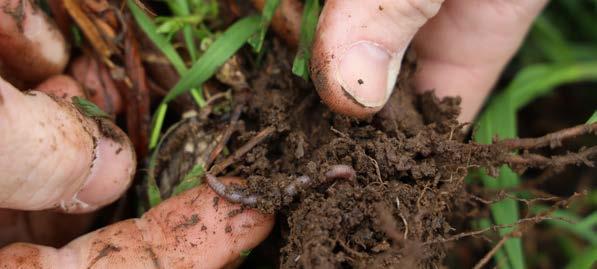 By Marlee Jackson
By Marlee Jackson
As Stan Usery Jr. pulls a chopped cotton stalk from the Limestone County soil, a treasure trove emerges.
It’s a late-winter bounty of wiggling worms, riotous roots and inches-deep organic matter. Those pay dividends for farmers like Usery, who cultivate soil health through reduced tillage, cover crops and more.
“It’s what’s underneath that counts,”
Usery said. “I can’t say I’ve figured it out, but I’m going to keep trying. I think the soil health benefits are worth the effort.”
Statistics back up the anecdotal information.
Thirty U.S. farms, including three from Alabama, recently took part in a study assessing the economic impact of soil health management systems (SHMS). In addition to Usery’s farm, the Soil Health Institute (SHI) and National Association of Conservation Districts conducted the survey on Shun Binford’s farm in Limestone County and Myron Johnson’s in Henry County.

Experts found farms implementing SHMS averaged saving $14 an acre growing corn, $7 an acre on soybeans and $16 an acre for remaining crops. Those savings seem small but could have an incredible impact over time, said
Stan Usery is one of three Alabama farmers whose soil health practices were part of a recent national economic impact study. He regularly plants cover crops behind low-residue row crops like cotton to reduce erosion and add organic matter to the soil.

Cover crops like bright green triticale help protect soil after row crops have been harvested. Earthworms and tendrils of roots are a sign of healthy soils when cotton stubble is pulled from the ground.
Alabama Farmers Federation’s Carla Hornady.
“In today’s tough farm economy, every dollar counts,” said Hornady, the Federation’s Cotton, Soybean and Wheat & Feed Grain divisions director. “Soil health isn’t a new concept, but it’s more important than ever to really think about the impact you’re having on your soil each year.”
The study also showed an increase in net farm income and yields. Excluding the study’s lone organic farm, growers averaged $65 an acre more when they used a suite of soil health practices.
Those practices don’t just save money. They protect and improve soil.
Take cover crops.

alfafarmers.org April 2024 | NEIGHBORS | 17
Usery has used cover crops since the late ‘90s. Last fall, he planted 400 acres of triticale, a wheat-rye hybrid, behind cotton. That’s important considering cotton is a low-residue crop. After harvest, cotton’s minimal residue decomposes rapidly, leaving the soil vulnerable to erosion.
Triticale and other popular cover crops like cereal rye, tillage radishes and black oats grow strong root systems that help prevent washing and return critical nutrients to the soil. That organic matter builds up over time, resulting in healthier soils that could net higheryielding crops.
Root channels also help break up the soil, which means farmers can rely less on conventional tillage, or using a mechanical implement to disc up compacted soil, before planting.
The state’s largest farm organization is forming public-private partnerships to help spread that message.
The Federation helped organize a 4R Nutrient Stewardship Field Day in February, when bright green cover crops coated fields at the Yara incubator farm in Shorter. The test site is one of five across North America and allows industry experts and Auburn University (AU) professors to trial soil health solutions.

During the event, farmers were encouraged to implement soil management techniques using the 4Rs: right source, right rate, right time and right place. Demonstrations focused on strip tilling cover crops, nitrogen management, soil fertility, nutrient stratification and irrigation sensors.
Sponsors included The Fertilizer Institute, Yara, AU’s College of Agriculture and the Alabama Cooperative Extension System.

Yara Soil Health Agronomist Curt Knight said most agronomic decisions are split in two buckets — soil degrading processes or soil conservation practices.
The former includes tillage,

fallow years, soil erosion, nutrient depletion and compaction, while lauded conservation practices include cover crops, reduced tillage, crop rotation, nutrient management and surface residue retention.
Jessica Kelton is a soil health educator with SHI. During the field day, she tackled the tough question: “How can farmers quantify soil health?”
While SHMS economics research shows the impact on farmers’ bottom line, SHI is investigating regionalspecific tests to measure soil health. Kelton encouraged farmers to pull samples each year in the same place. Those farmer-tested impacts include soil organic carbon and carbon mineralization potential.
Kelton hailed the importance of visual assessments, too.
Back in Limestone County, Usery gets it. He’s also practical, toeing the line of scientific evidence and logistical limits of cover crops.
“I believe in the benefits of soil health,” Usery said. “But you can’t paint with broad strokes. You’ve got to find out what works for your farm. It requires patience and trying something before you scale up.”
Scan for national and farm-by-farm soil health economics results.

 Auburn University’s Dr. Rishi Prasad dug into nutrient management during a recent soil health field day in Shorter. The Alabama Farmers Federation helped coordinate the field day to encourage farmers’ continued acceptance of practices that prioritize soil health.
Auburn University’s Dr. Rishi Prasad dug into nutrient management during a recent soil health field day in Shorter. The Alabama Farmers Federation helped coordinate the field day to encourage farmers’ continued acceptance of practices that prioritize soil health.
18 | NEIGHBORS | April 2024 alfafarmers.org
Auburn University and Alabama Cooperative Extension System experts demonstrated strip tilling cover crops during a recent soil health field day in
YOUR SOYBEANS ARE

IN FACT, YOU’RE READING THEM RIGHT NOW.
You can find soybeans grown in Alabama just about everywhere — your food, your food’s food, your fuel, asphalt, adhesives, motor oil, tires, paints, crayons and more. In fact, even this ad — and the whole magazine — is printed with soy ink. And as your Alabama Soybean Checkoff, we’re always on the job, researching and finding markets for your soybeans to keep this impressive list going on and on. Learn more about the story of soy at unitedsoybean.org/hopper.

©2023 United Soybean Board. [62728-4 5/23] AL L OVER.
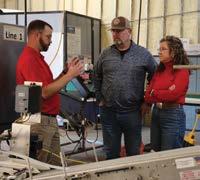
FARM TOURS EDUCATION FAMILY LUAU

AFVGA Conference Highlights Greatness on the Gulf
By Maggie Edwards
The Alabama Fruit & Vegetable Growers Association’s (AFVGA) Annual Conference and Trade Show brought almost 300 specialty crop farmers and industry leaders to Gulf Shores Feb. 14-16.
That included AFVGA board member Craig Goolsby of Silverhill Satsumas.
“I’m not a traditional farmer,” said Goolsby of Baldwin County. “I’m a second-career farmer. AFVGA pushes me to interface with folks who have more experience. It provides guidance and lets me know I’m not alone.”
One area of focus for Goolsby is marketing his fruit.

“This industry is a lot different than most areas of farming,” said Goolsby, a member of state agricultural branding program Sweet Grown Alabama. “Someone who deals with fruits and vegetables is not only a grower but a marketer of their own produce. The conference allowed me to meet business owners who are looking for products to sell in their storefronts.”
Attendees met Sweet Grown Alabama Director Ellie Watson at the organization’s interactive exhibit. Watson dove into program logistics and benefits during the luncheon on Day 2.
“We are here to help farmers sell their products to consumers,” Watson said. “Our friends at AFVGA have been with us since the beginning. We will continue to serve our producers and welcome new members to join.”
Along with Sweet Grown Alabama, 30 other vendors greeted guests during the trade show sponsored by Bejo Seeds, a global fruit and vegetable seed company.
“We love getting to visit with the growers,” said Dylan Teel of Bejo Seeds. “We network with other industry members, too. The conference helps expose all of us to what’s out there.”
Alabama native Teel received the AFVGA scholarship in 2019 while studying horticulture at Auburn University (AU).
“This is one of our favorite shows because it’s down home,” Teel said. “There are good grower contacts and impressive breakout sessions.”


Those educational sessions centered around vegetable production; orchard fruit and nuts; small fruit; and marketing and farm management.
Farm tours and workshops were on the agenda, too. The group visited Wildfork Blueberries in Brewton and the Gulf Coast Research & Extension Center in Fairhope for equipment demonstrations before arriving at The Lodge at Gulf State Park Feb. 14.
More hands-on learning took place during produce safety training with Alabama Department of Agriculture & Industries. Other workshops focused on hydroponics and protected agriculture, agricultural labor, variety trial research and flowers.
“The American-grown cut-flowers movement has increased the last few years,” said AFVGA Executive Director
 Sweet Grown Alabama Director Ellie Watson spoke to conference attendees on Day 2. Watson thanked AFVGA for its continued support of the state’s agricultural branding program.
AFVGA board member Jimmy Ferguson of Washington County and wife Katie visited with fellow leader Craig Goolsby of Baldwin County between the trade show and workshops.
Sweet Grown Alabama Director Ellie Watson spoke to conference attendees on Day 2. Watson thanked AFVGA for its continued support of the state’s agricultural branding program.
AFVGA board member Jimmy Ferguson of Washington County and wife Katie visited with fellow leader Craig Goolsby of Baldwin County between the trade show and workshops.
20 | NEIGHBORS | April 2024 alfafarmers.org


WORKSHOPS SILENT AUCTION TRADE SHOW
Blake Thaxton. “We believe farms have opportunities to create markets in the cut-flower industry. This workshop was a great introduction to the crop.”
The fun continued during a family luau. Special entertainment from duo Wylie Pete created a relaxed atmosphere as farm families placed bids at the silent auction, a new addition to the conference.
The AFVGA board incorporated the auction to fund the Jimmy Witt Memorial Scholarship. Generous farmers raised over $2,000.
“Jimmy was an integral member of AFVGA,” Thaxton said. “Since his passing, we honor his legacy by giving back to young people pursuing careers in agriculture.”
AU graduate student Savannah Busby of Jefferson County was presented the scholarship during the business session Feb. 16.
Bobby Boozer of Boozer Farms in Chilton County received the AFVGA

Exceptional Award for outstanding involvement.
“It’s humbling,” said Boozer, who worked with the Alabama Cooperative Extension System (ACES) for 26 years. “There are always people watching us who can be impacted for the rest of their lives. I have been affected by many of our members.”
Additionally, Dr. Chip East of ACES received the Service to Horticulture Award.
“When I think about the title of this honor, my mind goes to influential leaders like Dr. Wheeler Foshee and Dr. Arlie Powell,” said East, motioning to colleagues in the room. “Those are the ones who trained me. I am thankful for them and our farmers.”
Powell’s service to AFVGA dates to the 1980s when he helped create the association. He serves as the 2023-2024 AFVGA president and said it’s an honor to help fellow growers.
“In the past, we have hit some hard times,” said Powell, who owns Petals from the Past in Chilton County with son Jason. “Now we are pushing almost 300 people at the conference, and I’m proud of that.”
AFVGA joined the Alabama Farmers Federation as an affiliate association in 2016. That partnership has been fruitful, Powell said.
“Since joining the state’s largest farm organization, we have moved in the right direction,” he said. “We see a good mix of ages in our crowd. That’s what we need to keep growing.”
Learn more at AFVGA.org.





 Second from top: Auburn University graduate student Savannah Busby of Jefferson County was awarded the Jimmy Witt Memorial Scholarship. Second from bottom: Dr. Chip East of the Alabama Cooperative Extension System (ACES) received the Service to Horticulture Award. Bottom: Chilton County’s Bobby Boozer received the AFVGA Exceptional Award for outstanding involvement with the association and industry. Recipients are pictured with AFVGA President Dr. Arlie Powell, left, and AFVGA Vice President Larry LouAllen.
Alabama Cooperative Extension System’s Dr. Clement Akotsen-Mensah, left, and Edgar Vinson discussed educational sessions during breaks on the Dunes Terrace at The Lodge at Gulf State Park.
Second from top: Auburn University graduate student Savannah Busby of Jefferson County was awarded the Jimmy Witt Memorial Scholarship. Second from bottom: Dr. Chip East of the Alabama Cooperative Extension System (ACES) received the Service to Horticulture Award. Bottom: Chilton County’s Bobby Boozer received the AFVGA Exceptional Award for outstanding involvement with the association and industry. Recipients are pictured with AFVGA President Dr. Arlie Powell, left, and AFVGA Vice President Larry LouAllen.
Alabama Cooperative Extension System’s Dr. Clement Akotsen-Mensah, left, and Edgar Vinson discussed educational sessions during breaks on the Dunes Terrace at The Lodge at Gulf State Park.
Listen to the AFVGA Conference AgCast! alfafarmers.org April 2024 | NEIGHBORS | 21


22 | NEIGHBORS | April 2024 alfafarmers.org
Ornamental Grasses: The Other Grass in the Landscape
 By Rudy Pacumbaba
By Rudy Pacumbaba
Choosing plant materials for a landscape can be daunting. Selection begins with determining the plant’s future location, followed by selecting the right plant for the right place. Turfgrass is usually the backdrop for landscapes. However, ornamental grasses are often overlooked as an eye-catching, low-maintenance option.
Ornamental grasses have good qualities, including hardiness for extreme conditions, a unique visual appearance and multiple choices for color, texture and size. Ornamental grasses are available as true grasses and sedges and can have clumping or spreading growth characteristics. They are often perennial and have cool- and warm-season varieties. Cool-season ornamental grasses will have new growth during fall and winter before flowering in spring or early summer. Warm-season grasses will sprout new growth during spring and summer and flower in late summer or fall.
Ornamental grasses are a great
substitute for common shrubs. Unique characteristics allow these grasses to be used in landscapes in a myriad of ways. That includes soft perennial borders, container plants, unique bed backdrops, foundation plants, ground covers, flower-bed groupings, corner or entrance plants, and focal or specimen plants.
While they are a varied group, ornamental grasses prefer common growing conditions. Most like well-drained soil and full sun, which makes them ideal drought-tolerant choices. A few will tolerate shade to full shade, like Japanese forest grasses and North Sea oat grass. Some ornamental sedges and rushes thrive in moist or wet soils.
While many perennials — like cool-season grasses — prefer fall planting, warm-season ornamental grasses will do best when planted in spring. Plant spacing will vary depending on mature size (keep in mind plants’ clumping or creeping growth habit). Proper establishment with daily watering for up to two weeks will
ensure a deep and healthy root system to withstand dry periods.
Once established, most ornamental grasses will grow when given at least 1 inch of water per week. Fertilizer requirements likely depend on the location’s soil test results, but most ornamental grasses need little fertilizer.
Trimming or cutting back the grass usually occurs before the new season’s growth. Several ornamental grasses are chosen for their attractive characteristics during the winter, so cutting them back is usually done in late winter or early spring. Trim stems 6 to 12 inches above the ground (depending on the overall size of the clump). Several evergreen grasses, like sedges, will not tolerate being cut back and only require hand removal of old leaves in spring.
After three to four years of growth, divide the clump of grass. This helps maintain a healthy and manageable plant. Overgrown ornamental grasses will become thin or die out in the center of the clump.
alfafarmers.org April 2024 | NEIGHBORS | 23

Take Time for a Water Test
 By Katie Nichols
By Katie Nichols
Performing a water test is important when planning to drink water from private wells, but what about livestock and recreational ponds? It’s just as important to test these waters and ensure the safety of livestock and fish.
Alabama Cooperative Extension System forestry, wildlife and natural resources (FWNR) agents Bence Carter and Norm Haley recommend contacting local agents for help getting started.
Alkalinity and Hardness
“Many fishpond owners ask if their ponds need to be limed,” Haley said. “Alkalinity and hardness are tested to determine water quality and make recommendations.”
Measured calcium and magnesium concentrations play a role in fish health and productivity potential through fertilizer applications. To ensure proper water quality, landowners should administer water tests every few years.
Haley said many waters in Alabama are acidic or low in alkalinity and hardness. That’s alleviated by adding calcium carbonate in the form of agricultural limestone.
“Your regional FWNR agent can conduct alkalinity and hardness tests at no charge,” Haley said. “Simply drop off or mail the sample to the operating office of your local FWNR agent or aquatic specialist. You can find that location in the directory at aces.edu.”
Recognizing Residues
Carter said pinpointing residues in a water system can be a multistep process.
“There is not a general test to detect all pesticides or foreign chemicals
Water Test Tips
n Call the testing facility or laboratory for instructions.
n Use clean, well-rinsed plastic bottles. Do not use prescription bottles.
n Collect undisturbed, clean water.
n Leave as little air in the container as possible.
n Be specific about the source being tested — and why.
n Label sample containers with name, location, phone number and email address.
n Avoid shipping late in the week or delaying drop-off. Fresh samples are best.
n Do not leave samples in direct sunlight or a hot car.
n Refrigerate samples if not dropped off immediately.
n If shipping, remember leaky packages will not be delivered; the carrier will throw them out. Tighten and tape around the cap, place in a sealed gallon bag and ship in a box. Do not ship glass.
n Call local providers for public water supply test results. These are tested regularly.

in water or soils,” Carter said. “The laboratory needs to have an idea of the chemical or formulations they will test for. Some pesticides break down rapidly
in water; therefore, the test should be completed as soon as possible.”
Before submitting a sample, contact the Alabama Department of Agriculture & Industries’ Alabama Pesticide Residue Laboratory to speak with chemists. That conversation can pinpoint the correct test and then glean necessary information.
Algal Blooms
Some species of planktonic algae — also called harmful algal blooms (HABs) — can appear in a variety of colors that may look like spilled paint or coagulated surface floating masses. They are more common in the late summer and early fall and are driven by excess nitrogen and phosphorus.
These HABs can cause several issues, from skin and eye irritation to liver and kidney failure in humans, pets and livestock. Not all HABs are toxic, but when they occur, water should not be used until CyanoPros, a lab at Auburn University (AU), analyzes a sample.
Water Analysis
The AU Water Testing Laboratory can screen for micronutrients, macronutrients and minerals — along with hardness, alkalinity, conductivity, soluble salts and dissolved solids. These tests will help answer many questions related to water quality for agricultural, industry and private use.
Learn More
Find contact information and mailing addresses for each water testing facility in Alabama in the Alabama Extension publication
“Water Testing in Alabama: Why, Where & How.”

alfafarmers.org April 2024 | NEIGHBORS | 25




TOLD GLORY
he flag flies above the hardware store. There isn’t much of a breeze today. It moves with each gust, then becomes slack.
Flags hang from all sorts of places. They adorn bank buildings, supermarkets, schools, gas stations, beauty salons, auto shops, and libraries. There’s one on my front porch, too.
At the entrance to the hardware store, just beneath the flagpole, are Boy Scouts. I don’t exactly know what they’re doing. When I pass they look like they’re busy hard-selling a woman who’s buying some hanging ferns.
I walk through the store and get what I need — screws, a replacement electrical breaker and a half-inch drill bit. Then I check out.
My cashier wears a lapel pin on her vest that is a miniature American flag. Another pin bears the Army logo. Another is a mini POW/MIA flag.
“I like your pins,” I tell her.
“Thanks.”
“Military?”
“I just got outta the Army. I miss it. I wish I woulda stayed in. It’s hard going back to this kinda life.”
She spent her formative years in the service, you could say. She knew she wanted to make it a career, since the first time she saw her father wear dress blues. She was born on a military base. She was raised hearing the national anthem once per day over a loudspeaker. Her brother is Army.
I thank her, and I tell her to thank her brother and father for me.
I step outside. The Scouts ask if I need help to my truck. I have one bag.
Then again, I write a column for a living. I’m always looking for things to write about. I hand them the bag.
One carries it. One follows.

I ask what they are raising money for. I am ready to take out my wallet and contribute to a good cause.
I was a Scout. It’s a brotherhood. Also, I am pretty good with a campfire.
But the boys tell me they aren’t raising money; they just want to help.
“Aren’t you trying to earn a merit badge?” I ask.
They shake their heads. “No sir, we’re here with our dad, just being helpful.”
Another says, “Mostly, we just lift heavy things for old people who can’t.”
I try to donate to them. They almost gag. Accepting money for kindness is against a Scout’s honor.
“No sir,” says one. “We couldn’t.”
We shake hands. I thank them for helping an old man.
Then I drive through town and I notice more than I usually do. I see a man in a wheelchair, rolling along the side of the road. His cap is dark blue, with a battleship on the front.
I see a building in the distance with an eagle painted on the side.
I see little flags in the yard of a business that sells used furniture.
I see bumper stickers with the Stars and Stripes, too many to count.
My grandfather gave his entire youth to the service of country and his adulthood. My uncles saw Vietnam. My mother was born on a military base.
It goes unnoticed sometimes, but it is always there. It’s displayed on the roofs of municipal buildings, churchyards, hardware stores and on the right sleeves of adolescent Boy Scouts everywhere.
Each front porch on my street has one. Yours probably does, too. The flag hanging beside my own door has been there a long time. And it always will be.
I just thought I’d tell you why. ■

26 | NEIGHBORS | April 2024 alfafarmers.org

Taste of Alabama Flush with Delicious Food, Fruitful Discussions
environment where we can have conversations and serve food from across Alabama,” Upchurch said. “It gives us an opportunity to build relationships with our legislators, which I believe is very important to farmers.”
By Tanner Hood
Farmers and elected officials gathered around the table Feb. 21 to enjoy Alabama-grown products and discuss important issues during the Taste of Alabama Legislative Reception in Montgomery.
State Sen. Robert Stewart, D-Selma, serves on the Senate Ag, Conservation and Forestry Committee. He said he treasures every opportunity to meet farmers and promote agriculture.
“Ag is the cornerstone of our economy,” said Stewart. “It’s such an honor to interact with people who really undergird our communities and make sure they are sustainable.”
Hosted by the Alabama Farmers Federation, the reception provides farmer-leaders the opportunity to display homegrown products while getting in the weeds about policy. Attendees included over 100 legislators, constitutional officers and other government officials.
Clay County Farmers Federation President Chris Upchurch said events like Taste of Alabama ensure leaders hear directly from constituents about real-life issues. During the reception, Upchurch and wife Jordyn served spicy sliders made with beef from their Rockin’ U Farm. Jordyn serves on the Federation State Young Farmers Committee.
“Taste of Alabama allows our legislators and farmers to come together in a room with a good
Guests enjoyed the best Alabama farmers have to offer during the annual event at the Federation home office. In addition to sliders, this year’s menu included Bishop’s Barbecue, Colbert County; fried catfish from Consolidated Catfish, Greene County; honey from State Bee & Honey Committee members; lamb meatballs from HD Farm, Talladega County; peanut butter energy bites from the Alabama Peanut Producers Association; shrimp and grits from Greene Prairie Shrimp, Greene County; sweet treats and samples from Priester’s Pecans, Lowndes County; vanilla ice cream from Blue Ribbon Dairy, Elmore County; venison loin from Venison Provisions, Macon County; and more.
State Rep. Jennifer Fidler, R-Fairhope, grew up on a farm and serves on the House Agriculture and Forestry Committee. She said she hopes her peers took advantage of face-toface conversations with producers.

“Our legislators do need to see how hard farmers work every day,” Fidler said. “I think farmers being involved with lawmakers is important so they can see our grassroots effort, too, and know we can make good changes while taking care of the folks who take care of us all the time.”
State Rep. Ben Robbins, R-Sylacauga, said farmers are essential to Alabama and local economies.
“Agriculture is the backbone of Alabama,” Robbins said. “We have to hear from ag producers to know what’s actually going to benefit the entire state.”
In addition to legislators, Federation members mingled with Gov. Kay Ivey and other constitutional officers. Upchurch said the magnitude of attendees spoke volumes about the hours of work county Farmers Federations invest in building relationships with elected officials.
“We know it’s a busy time, and we appreciate everyone who came out to speak with us,” Upchurch said. “We’ve had good conversations, and I know our officials will take them to heart and use them to better Alabama.”
 The Taste of Alabama Legislative Reception allowed farmers to connect with elected officials like Rep. Susan DuBose, R-Hoover. DuBose and fellow leaders enjoyed cowboy beef sliders from Rockin’ U Farm in Clay County.
Clay County Farmers Federation President Chris Upchurch and wife Jordyn spoke with elected officials about current issues while serving homegrown beef sliders from their Rockin’ U Farm.
The Taste of Alabama Legislative Reception allowed farmers to connect with elected officials like Rep. Susan DuBose, R-Hoover. DuBose and fellow leaders enjoyed cowboy beef sliders from Rockin’ U Farm in Clay County.
Clay County Farmers Federation President Chris Upchurch and wife Jordyn spoke with elected officials about current issues while serving homegrown beef sliders from their Rockin’ U Farm.
alfafarmers.org April 2024 | NEIGHBORS | 27
Montgomery County Farmers Federation board member Laslie Hall, left, visited with Rep. Curtis Travis, D-Tuscaloosa, and discussed issues facing Alabama farmers.

Welcome back, family! Spring has sprung, and it’s time to celebrate being on our way to sunshiny skies and warmer temperatures. I’ve got all the flavors of a spring celebration for you this month, so make your grocery lists, and let’s get cooking.
First up is a fresh new take on a Southern classic, Pineapple Chicken Salad. This recipe takes your standard chicken salad and elevates it to new levels with the addition of juicy tidbits of pineapple. We’re also jazzing it up with the richness of toasted pecans. It may sound hard to imagine, but once you take that first bite, you’ll wonder where it’s been all your life.
Next up are Cheese Straw Cookies. Alabama is known for cheese straws,

which is something I didn’t realize until I began giving them to friends from out of state. However, anyone who has made them knows cheese straws can be a bit on the fussy side. A cheese straw cookie, however, offers up the same taste and texture but in a fraction of the time.
Last, but not least, Alabama Farmers Federation member Carolyn Hill of Talladega County is sharing her must-make recipe for Frozen Strawberry Salad. This recipe was originally shared in the March 2006 Neighbors, and it’s just as delicious nearly 20 years later. You can make this in one 9-inch-by13-inch pan or make individual salads in little muffin tins. This fruit salad is convenient for popping in the freezer in
Pineapple Chicken Salad
Prep Time Servings
25 mins 6 to 8
Ingredients
4 cups finely chopped cooked chicken
3/4 cup mayonnaise
2 teaspoons Dijon mustard
1 (20-ounce) can pineapple tidbits in juice, well drained (or 2 cups finely diced fresh pineapple)
1/2 cup coarsely chopped pecans, toasted
2 ribs celery, finely diced (about 2/3 cup)
1/4 red onion, finely diced (about 1/3 cup)
1/2 cup dried cranberries
Salt Pepper Instructions
In a large bowl, add chicken, mayonnaise and Dijon mustard. Stir to combine.
Add pineapple, pecans, celery, onion and cranberries. Toss to coat in the dressing. Add salt and pepper to taste.
Cover and refrigerate at least an hour to allow flavors to meld. Serve on crackers, in sandwiches, etc.
case you have a last-minute event — and it’s budget-friendly.
With the onset of spring, I always find myself grateful for new beginnings and another year of getting to do what I love alongside my friends and family at the Farmers Federation. May we never forget to count our blessings, and may they always be too numerous for us to reach a final tally!
 Stacey Little
Stacey Little
 Stacey Little is a foodie, recipe developer and cookbook author whose Southern Bite blog helps families put simple, down-to-earth food on the table while preserving Southern cooking for future generations. See more recipes at southernbite.com.
Stacey Little is a foodie, recipe developer and cookbook author whose Southern Bite blog helps families put simple, down-to-earth food on the table while preserving Southern cooking for future generations. See more recipes at southernbite.com.
28 | NEIGHBORS | April 2024 alfafarmers.org
Frozen Strawberry Salad
 By Carolyn Hill, Talladega County
By Carolyn Hill, Talladega County
Prep Time Freeze Time Servings
25 mins 4 hrs 12 to 16
Ingredients
3/4 cup sugar
1 (8-ounce) block cream cheese, room temperature
1 (20-ounce) can pineapple tidbits, drained
2 bananas, sliced and quartered
1 (10-ounce) package frozen strawberries with juice
2 cups chopped pecans
1 (12-ounce) container frozen whipped topping
Instructions
In a large bowl using an electric mixer, cream the sugar and cream cheese. Gently mix in all fruit and pecans, then
fold in topping. Spray a 9-inch-by-13inch dish with non-stick cooking spray or prepare a 12-count muffin tin with muffin liners. Spread mixture into prepared dish or muffin tins. Freeze. Remove from freezer about 10 minutes before serving.
Stacey’s Recipe Notes:
I couldn’t find frozen strawberries in juice, so I used a bag of plain, sliced frozen strawberries. I do miss the delightful pink color the original ingredient adds, but it still tasted great! I imagine a 1-pound container of fresh strawberries that have been hulled and sliced would work, too.
For even more flavor, toast pecans in a 350 F oven about 5 minutes or until fragrant. Allow them to cool completely

Frozen whipped topping, a.k.a. Cool Whip, is no longer sold in a 12-ounce container. I grabbed a 16-ounce container and used about 3/4 of it in the mixture and used the leftover as a topping.
I reserved a little of each of the pecans, strawberries and pineapple and sprinkled them over the top to give the dish a little


Cheese Straw Cookies
Prep Time Cook Time Makes 20 mins 30 mins 24 cookies

Ingredients
1 (8-ounce) block sharp cheddar cheese
3/4 cup unsalted butter, room temperature
1 teaspoon salt
1/2 teaspoon garlic powder
1/2 to 1 teaspoon cayenne powder (to taste)
2 cups all-purpose flour
Instructions
Heat oven to 350 F and line a baking sheet with parchment paper or a silicone baking mat. Use a box grater to shred the cheese. In a large bowl using an electric mixer, blend the cheese and butter together until smooth. Add salt, garlic powder and cayenne. Mix to
combine. Gradually add flour and mix well.
Use a 1 1/2 tablespoon cookie scoop to measure the dough out. Place each scoop about 2 inches apart on the pan. If desired, use a fork to gently press tines into the top of each cookie. Dipping the fork in water will help.
Bake 20 to 30 minutes or until golden brown. Bake shorter for a crispy exterior and chewy interior. Bake longer for crispness throughout. Cool about 10 minutes on the baking sheet before moving to a cooling rack. Work in batches until all the dough has been used. Store on the counter in an airtight container for up to a week.
alfafarmers.org April 2024 | NEIGHBORS | 29


























New and Used Vehicle Loans DRIVING DOWN RATES Save with Farm Bureau Bank® in the passenger seat! Leave high rates in the rearview this year with a vehicle loan from Farm Bureau Bank! Learn about our competitive rates, flexible terms, and protection plans today. Contact your local Alfa Insurance o ce for our current rates and apply today! 1Protection options may vary based on collateral. 2Farm Bureau® Member Rewards Mastercard® credit card offer may be available on the auto loan application. Approval limits based on credit qualifications. Please see Terms and Conditions on farmbureau. bank for additional details about the Farm Bureau Member Rewards Mastercard. Rates and financing are limited to new or used “collateral” 2012 and newer. For our current rates and conditions, visit farmbureau.bank. Non-member rates may be higher than posted rates. All loans are subject to credit approval, verification and collateral evaluation. This offer is not available in all states and rates and terms are subject to change without notice. Farm Bureau, FB, and the FB National Logo are registered service marks owned by, and used by Farm Bureau Bank FSB under license from, the American Farm Bureau Federation. 6.2023 farmbureau.bank • 800.492.3276 Guaranteed Asset Protection1 Credit Card O er with Approved Loan2 Major Mechanical Protection1
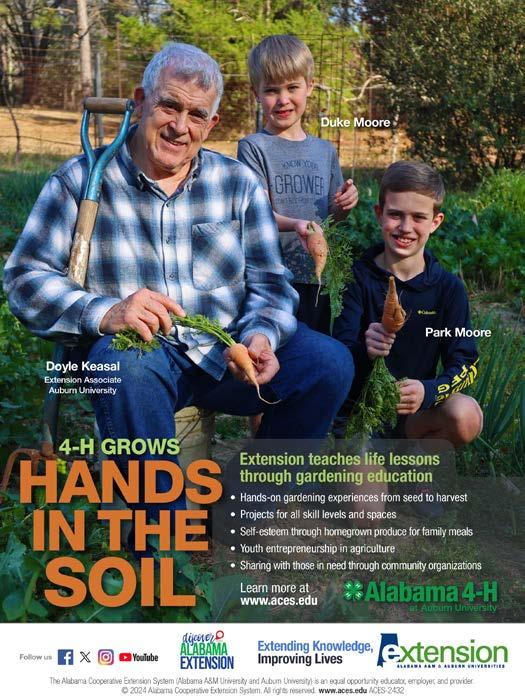




 Photo By Maggie Edwards
Photo By Maggie Edwards



 By Marlee Jackson
By Marlee Jackson

 By Marlee Jackson
By Marlee Jackson





 By Tanner Hood
By Tanner Hood




 By Maggie Edwards
By Maggie Edwards










 By Maggie Edwards
By Maggie Edwards


 Coleman Lett of Calhoun County and Cody Castleberry of St. Clair County joined fellow Young Farmers during the conference welcome reception at The Lodge at Gulf State Park.
Alabama Farmers Federation 2024 Outstanding Young Farm Family finalists are Lauren and Drew Wendland, Autauga County; Robin and Garrett Dixon, Lee County; and Amanda and Whit Lovelady, Talladega County. From left are Federation State Young Farmers Committee Chair Dillon Turk of Mobile County, the Wendlands, the Dixons, the Loveladys, Federation Executive Director Paul Pinyan and Federation Young Farmers Division Director Hunter McBrayer.
Coleman Lett of Calhoun County and Cody Castleberry of St. Clair County joined fellow Young Farmers during the conference welcome reception at The Lodge at Gulf State Park.
Alabama Farmers Federation 2024 Outstanding Young Farm Family finalists are Lauren and Drew Wendland, Autauga County; Robin and Garrett Dixon, Lee County; and Amanda and Whit Lovelady, Talladega County. From left are Federation State Young Farmers Committee Chair Dillon Turk of Mobile County, the Wendlands, the Dixons, the Loveladys, Federation Executive Director Paul Pinyan and Federation Young Farmers Division Director Hunter McBrayer.







 By Marlee Jackson
By Marlee Jackson













 Sweet Grown Alabama Director Ellie Watson spoke to conference attendees on Day 2. Watson thanked AFVGA for its continued support of the state’s agricultural branding program.
AFVGA board member Jimmy Ferguson of Washington County and wife Katie visited with fellow leader Craig Goolsby of Baldwin County between the trade show and workshops.
Sweet Grown Alabama Director Ellie Watson spoke to conference attendees on Day 2. Watson thanked AFVGA for its continued support of the state’s agricultural branding program.
AFVGA board member Jimmy Ferguson of Washington County and wife Katie visited with fellow leader Craig Goolsby of Baldwin County between the trade show and workshops.







 Second from top: Auburn University graduate student Savannah Busby of Jefferson County was awarded the Jimmy Witt Memorial Scholarship. Second from bottom: Dr. Chip East of the Alabama Cooperative Extension System (ACES) received the Service to Horticulture Award. Bottom: Chilton County’s Bobby Boozer received the AFVGA Exceptional Award for outstanding involvement with the association and industry. Recipients are pictured with AFVGA President Dr. Arlie Powell, left, and AFVGA Vice President Larry LouAllen.
Alabama Cooperative Extension System’s Dr. Clement Akotsen-Mensah, left, and Edgar Vinson discussed educational sessions during breaks on the Dunes Terrace at The Lodge at Gulf State Park.
Second from top: Auburn University graduate student Savannah Busby of Jefferson County was awarded the Jimmy Witt Memorial Scholarship. Second from bottom: Dr. Chip East of the Alabama Cooperative Extension System (ACES) received the Service to Horticulture Award. Bottom: Chilton County’s Bobby Boozer received the AFVGA Exceptional Award for outstanding involvement with the association and industry. Recipients are pictured with AFVGA President Dr. Arlie Powell, left, and AFVGA Vice President Larry LouAllen.
Alabama Cooperative Extension System’s Dr. Clement Akotsen-Mensah, left, and Edgar Vinson discussed educational sessions during breaks on the Dunes Terrace at The Lodge at Gulf State Park.


 By Rudy Pacumbaba
By Rudy Pacumbaba

 By Katie Nichols
By Katie Nichols









 The Taste of Alabama Legislative Reception allowed farmers to connect with elected officials like Rep. Susan DuBose, R-Hoover. DuBose and fellow leaders enjoyed cowboy beef sliders from Rockin’ U Farm in Clay County.
Clay County Farmers Federation President Chris Upchurch and wife Jordyn spoke with elected officials about current issues while serving homegrown beef sliders from their Rockin’ U Farm.
The Taste of Alabama Legislative Reception allowed farmers to connect with elected officials like Rep. Susan DuBose, R-Hoover. DuBose and fellow leaders enjoyed cowboy beef sliders from Rockin’ U Farm in Clay County.
Clay County Farmers Federation President Chris Upchurch and wife Jordyn spoke with elected officials about current issues while serving homegrown beef sliders from their Rockin’ U Farm.


 Stacey Little is a foodie, recipe developer and cookbook author whose Southern Bite blog helps families put simple, down-to-earth food on the table while preserving Southern cooking for future generations. See more recipes at southernbite.com.
Stacey Little is a foodie, recipe developer and cookbook author whose Southern Bite blog helps families put simple, down-to-earth food on the table while preserving Southern cooking for future generations. See more recipes at southernbite.com.
 By Carolyn Hill, Talladega County
By Carolyn Hill, Talladega County
























